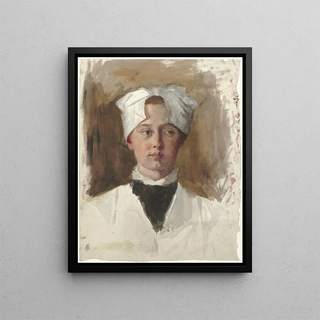Art print | Portrait of an Orphan Girl - Thérèse Schwartze


View from behind

Frame (optional)
In the vast panorama of art history, certain works stand out for their ability to evoke deep emotions and capture fleeting moments of life filled with delicacy. The "Art print of an orphan girl" by Thérèse Schwartze is one of those creations that, through its apparent simplicity, reveals a fascinating emotional complexity. This painting, depicting a young girl with a melancholic gaze, immerses us in a universe where solitude and hope coexist. Through this piece, Schwartze invites us to reflect on the human condition, inner struggles, and dreams of a better future.
Style and uniqueness of the work
Thérèse Schwartze's style is characterized by a realistic approach, where every detail is carefully crafted to convey the very essence of her subjects. In the "Art print of an orphan girl," light plays a crucial role, highlighting the delicate features of the child while creating an intimate atmosphere. The nuances of colors, ranging from warm tones to deeper shadows, demonstrate impressive technical mastery. The composition, meanwhile, is designed to guide the viewer's gaze toward the face of the orphan girl, emphasizing the importance of her expression. This artistic choice enhances the emotional impact of the piece, making palpable the sadness and hope emanating from this young figure.
The artist and her influence
Thérèse Schwartze, an emblematic figure of 19th-century Dutch painting, managed to establish herself in an artistic environment often dominated by men. Her journey, marked by unwavering determination, led her to explore various themes, always with a particular sensitivity for portraits. Schwartze captured the essence of her models, going beyond simple representation to offer genuine psychological introspection. Her influence endures today, inspiring many contemporary artists who seek to combine technique and emotion in their creations. Through her work, she paved the way for a new understanding of portraiture, where psychological depth is emphasized.
An exceptional wall decoration signed Artem Legrand
In the

Matte finish

View from behind

Frame (optional)
In the vast panorama of art history, certain works stand out for their ability to evoke deep emotions and capture fleeting moments of life filled with delicacy. The "Art print of an orphan girl" by Thérèse Schwartze is one of those creations that, through its apparent simplicity, reveals a fascinating emotional complexity. This painting, depicting a young girl with a melancholic gaze, immerses us in a universe where solitude and hope coexist. Through this piece, Schwartze invites us to reflect on the human condition, inner struggles, and dreams of a better future.
Style and uniqueness of the work
Thérèse Schwartze's style is characterized by a realistic approach, where every detail is carefully crafted to convey the very essence of her subjects. In the "Art print of an orphan girl," light plays a crucial role, highlighting the delicate features of the child while creating an intimate atmosphere. The nuances of colors, ranging from warm tones to deeper shadows, demonstrate impressive technical mastery. The composition, meanwhile, is designed to guide the viewer's gaze toward the face of the orphan girl, emphasizing the importance of her expression. This artistic choice enhances the emotional impact of the piece, making palpable the sadness and hope emanating from this young figure.
The artist and her influence
Thérèse Schwartze, an emblematic figure of 19th-century Dutch painting, managed to establish herself in an artistic environment often dominated by men. Her journey, marked by unwavering determination, led her to explore various themes, always with a particular sensitivity for portraits. Schwartze captured the essence of her models, going beyond simple representation to offer genuine psychological introspection. Her influence endures today, inspiring many contemporary artists who seek to combine technique and emotion in their creations. Through her work, she paved the way for a new understanding of portraiture, where psychological depth is emphasized.
An exceptional wall decoration signed Artem Legrand
In the






